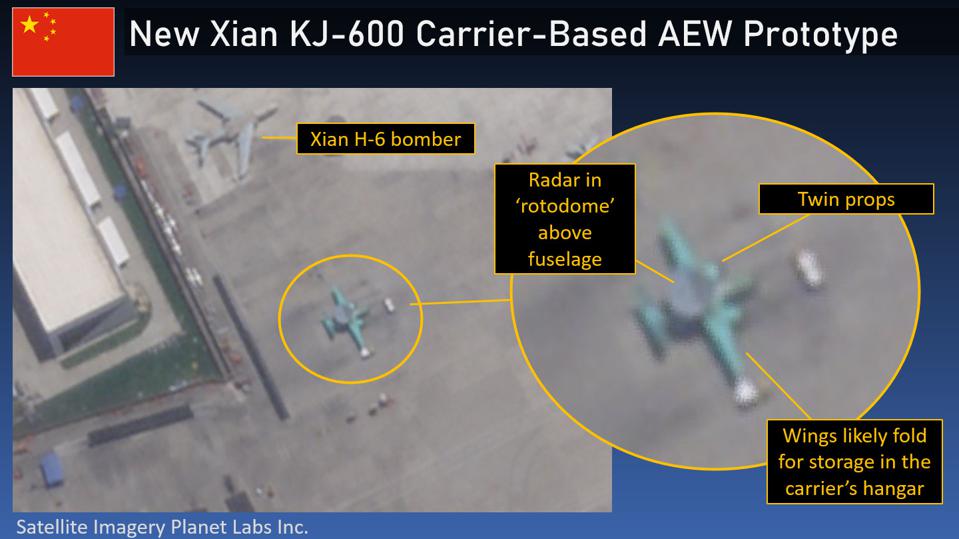
SOURCE: FORBES
The Chinese Navy is building a fleet of aircraft carriers that will be the second largest in the world. However, they currently lack airborne early warning (AEW) aircraft, which is considered a vital component of a balanced air wing. This is set to change with the introduction of the Xian KJ-600 carrier-borne AEW aircraft. It looks remarkably like the U.S. Navy’s E-2C Hawkeye.
The prototype KJ-600 has been spotted in satellite imagery of the Xi’an Aircraft Industrial Corporation’s airfield at Xian-Yanliang in central China. This is where many prototype planes are first seen. Chris Biggers, an imagery intelligence expert, identified the new aircraft in commercial satellite imagery provided by Planet Labs.
Although these are the first images of the prototype, evidence of the KJ-600 program has been seen before. A mock-up of the plane was spotted in August 2018 on a full scale concrete aircraft carrier built hundreds of miles inland at Wuhan. This training facility is used by the Chinese Navy to test deck layouts.
And Xian Industrial Corporation has previously flown the experimental JZY-01 AEW aircraft. This was based on the Xian Y-7 transport aircraft. The twin-prop Y-7 is itself based on the famous Antonov An-24 aircraft. It was widely seen as a demonstrator for the KJ-600, which is similar to the JZY-01 but more compact and generally more refined.
The layout is remarkably similar to the U.S. Navy’s E-2 Hawkeye family of aircraft. They are both twin turboprop aircraft with high-mounted long straight wings that can fold for carrier storage. They have a relatively small fuselage just large enough for a crew of 4 to 6. The radar is carried in a large rotodome atop the fuselage. Lastly the tail is split into several smaller vertical stabilizers, like bombers of World War II.
The layout of the two planes is virtually identical, to the point that aircraft recognition may prove a challenge in the future. The Hawkeye is a well proven design that first flew 60 years ago, and is still in service aboard U.S. and French aircraft carriers.
This may be a case of form following function, although there can be little doubt that the Hawkeye was the inspiration for the KJ-600. The same can be said of the Russian Yakovlev Yak-44, which had once been destined to operate from the U.S.S.R’s carriers.
It is not yet known whether the KJ-600’s radar actually rotates. An alternative is to have three or more fixed arrays which together cover in all directions. China uses both approaches in different aircraft. But the satellite images shows just one darker leading edge segment. This suggests a single radar array, which logically has to rotate to cover 360 degrees. The exact radar configuration may be confirmed in future images.
There is also a question mark as to whether the KJ-600 will be able to operate from China’s first two carriers, because they use a ski-jump instead of a catapult, so aircraft have to launch using only their own power.
But China’s first indigenous carrier-borne AEW aircraft is real. It is seen as a major development and capability leap for the Chinese Navy. Together with new carriers, and new operating facilities, it is part of a sea change in China’s naval power.






